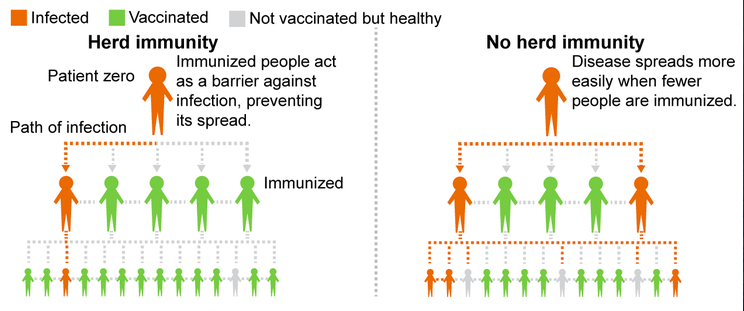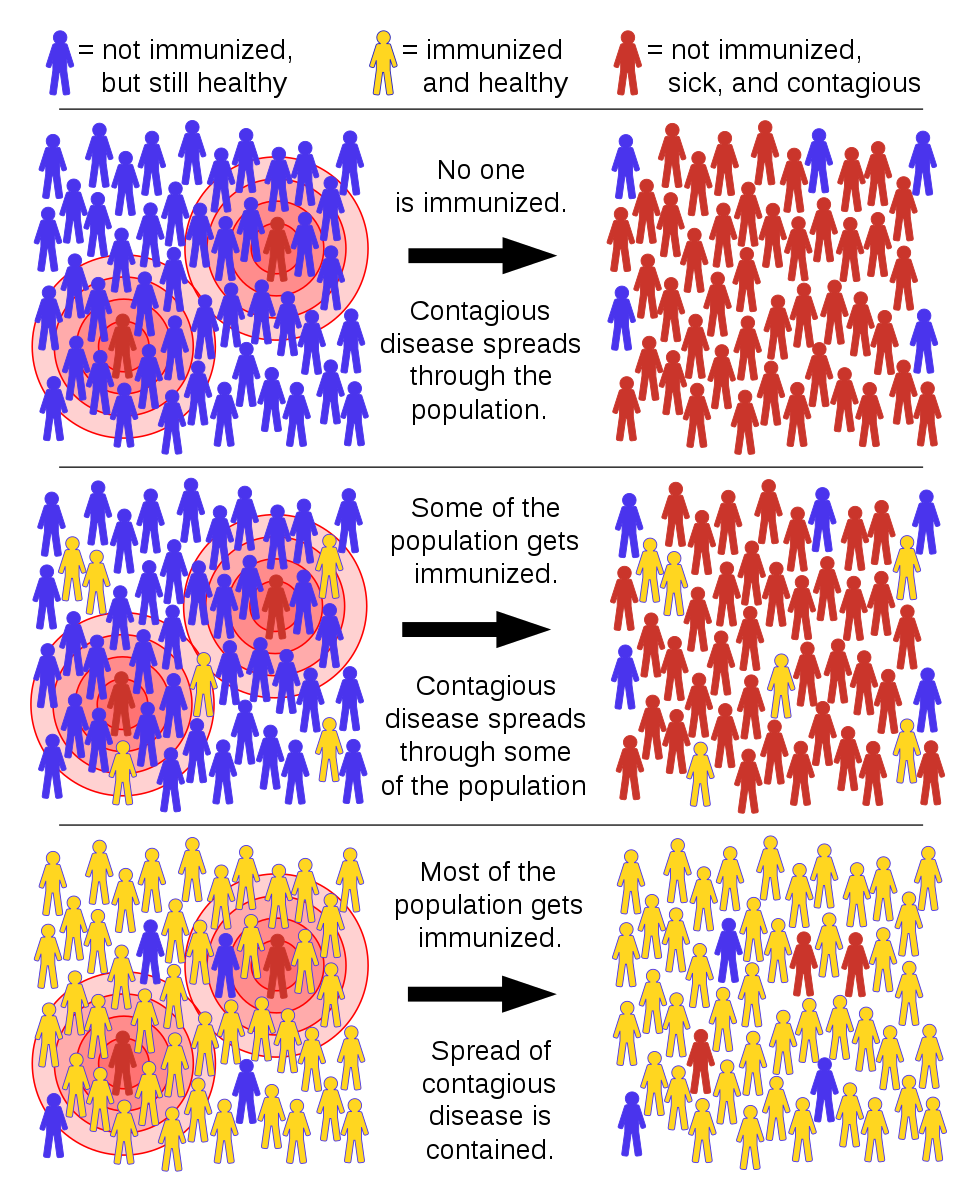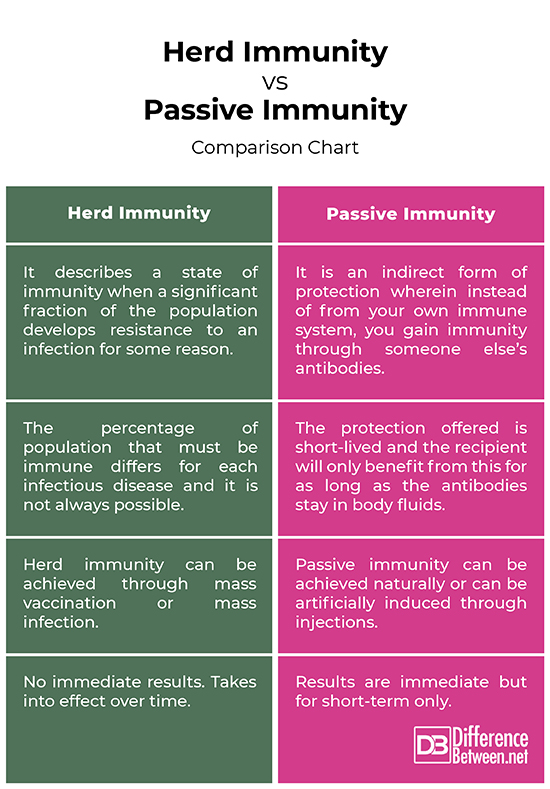Difference Between Herd Immunity and Passive Immunity
Immunity refers to the ability of the human body to fight off against an infectious disease or infection. It is a kind of protection against foreign pathogens conferred either by the bodily immune response generated by immunization or through past infection or other immunological factors. An individual develops immunity against a specific infection or disease through one of many ways. We are here to talk about two such types of immunity – herd immunity and passive immunity.

What is Herd Immunity?
Herd Immunity is a state of protection of a group or community against subsequent spread of an infectious disease. When a large fraction of the population somehow develops resistance to the infection for some reason other than prior exposure or immunization, it breaks the chain of subsequent spread of the disease or infection. At this point, it is safe to say that the infection is highly unlikely to spread because a significant number of people have reached the stage of ‘herd immunity’. Although, not every individual is immune, the group or ‘herd’ is protected, making it difficult for the infection to spread. For example, let’s say 70 percent of the population develops immunity against an infection, so three or four out of every five people who meet someone with the infection won’t be able to spread the infection any further, which subsequently keeps the infection under control. It is not necessary to achieve 100 percent herd immunity to contain a disease.

What is Passive Immunity?
Passive Immunity is an indirect form of protection against a disease but instead of from your own immune system, you gain immunity through someone else’s antibodies. Human body automatically develops antibodies against a pathogen through naturally acquired active immunity. But in some cases, the body of an individual does not produce its own antibodies but depends on readymade antibodies. This is called passive immunity because the recipient’s immune system plays no active role in fighting the pathogen. Passive immunity can be classified into two types: natural and artificial. Naturally acquired passive immunity is acquired when the fetus receives antibodies from its mother through the placenta. After birth, the newborn receives maternal antibodies through colostrums and breast milk. Artificially induced passive immunity is acquired by ready-to-use injection of antibodies, such as gamma globulin or antisera.
Difference between Herd Immunity and Passive Immunity
Meaning
– Herd immunity describes a state of immunity acquired when a significant fraction of the population develops resistance to an infection for some reason other than prior exposure or immunization, and which breaks the chain of subsequent spread of the infection. At this point, the infection is highly unlikely to spread because a significant number of people have reached the stage of ‘herd immunity’. Passive immunity is a different type of immunity which is acquired when a person’s own immune system plays no active role in fighting the pathogen; instead, he is given someone else’s antibodies.
State
– Passive immunity is a different kind of immunity which provides immediate protection through loaned antibodies and there is no secondary response. The protection offered is short-lived and the recipient will only benefit from this for as long as the antibodies stay in body fluids. Passive immunity can be either acquired naturally or artificially induced. Herd immunity is a key concept in epidemic control which states that only a fraction of the population needs to be immune to an infectious disease in order to stop the further spread of the disease.
Method
– Herd immunity can be achieved through mass vaccination because it is still the most reliable to achieve this state of protection. Widespread vaccination is a preventive measure against spread of the infectious disease, thereby protecting susceptible individuals from infection. However, the percentage of population to vaccinate differs for each infectious disease and it is not always possible, particularly in the case of the novel coronavirus. Another way to achieve herd immunity is through mass infection.
Passive immunity, on the other hand, can be achieved naturally from the mother to the baby through the placenta and breast milk or colostrums. Passive immunity can also be artificially induced through ready-to-use injection of antibodies, such as gamma globulin or antisera.
Herd Immunity vs. Passive Immunity: Comparison Chart

Summary of Herd Immunity vs. Passive Immunity
The immunity which a person acquires over time is called acquired immunity. Passive immunity is a different story; instead of depending on its own immune system, a person relies on loaned antibodies from someone else. In passive immunity, the recipient’s own immune system does not play any active role in fighting the pathogen and so there is no latent period. The results are almost immediate but the effects are short-lived and they are also less effective than active immunization. Passive immunity can be achieved naturally through the mother to her newborn child, or artificially induced when antibodies of a healthy individual is being transferred to a non-immune individual via injections. Herd immunity on the other hand, is a state in which the transmission of an infectious disease from human to human is highly unlikely to spread because a significant fraction of the population becomes immune.
- Difference Between Caucus and Primary - June 18, 2024
- Difference Between PPO and POS - May 30, 2024
- Difference Between RFID and NFC - May 28, 2024
Search DifferenceBetween.net :
Leave a Response
References :
[0]Gerstman, B. Burt. Epidemiology Kept Simple: An Introduction to Traditional and Modern Epidemiology. New Jersey, United States: John Wiley & Sons, 2003. Print
[1]Boslaugh, Sarah and Louise-Anne McNutt. Encyclopedia of Epidemiology, Volume 1. California, United States: SAGE Publishing, 2008. Print
[2]Kartikeyan, S. et al. HIV and AIDS: Basic Elements and Priorities. Berlin, Germany: Springer, 2007. Print
[3]Pillitteri , Adele. Maternal & Child Health Nursing: Care of the Childbearing & Childrearing Family. Pennsylvania, United States: Lippincott Williams & Wilkins, 2010. Print
[4]Vasanthakumari, R. Textbook of Microbiology. New Delhi, India: BI Publications Pvt Ltd, 2007. Print
[5]Image credit: https://commons.wikimedia.org/wiki/File:Herd_immunity.svg
[6]Image rcedit: https://commons.wikimedia.org/wiki/File:Herd_Immunity_vs_Without_Herd_Immunity_.png
